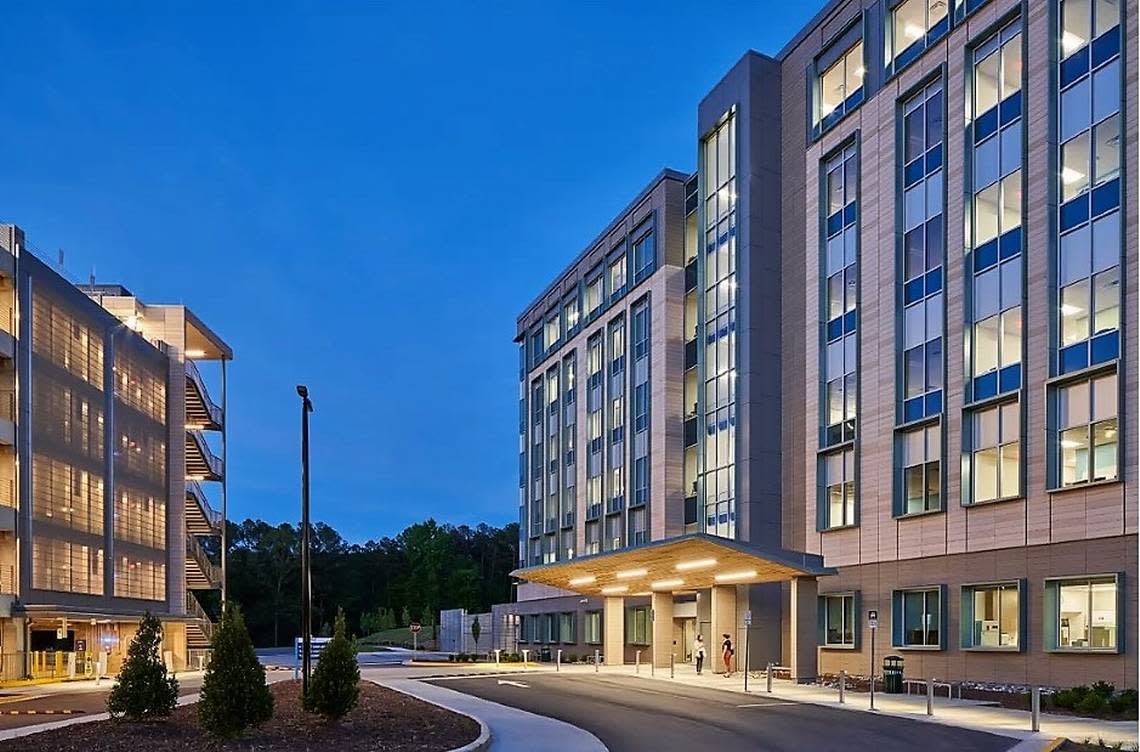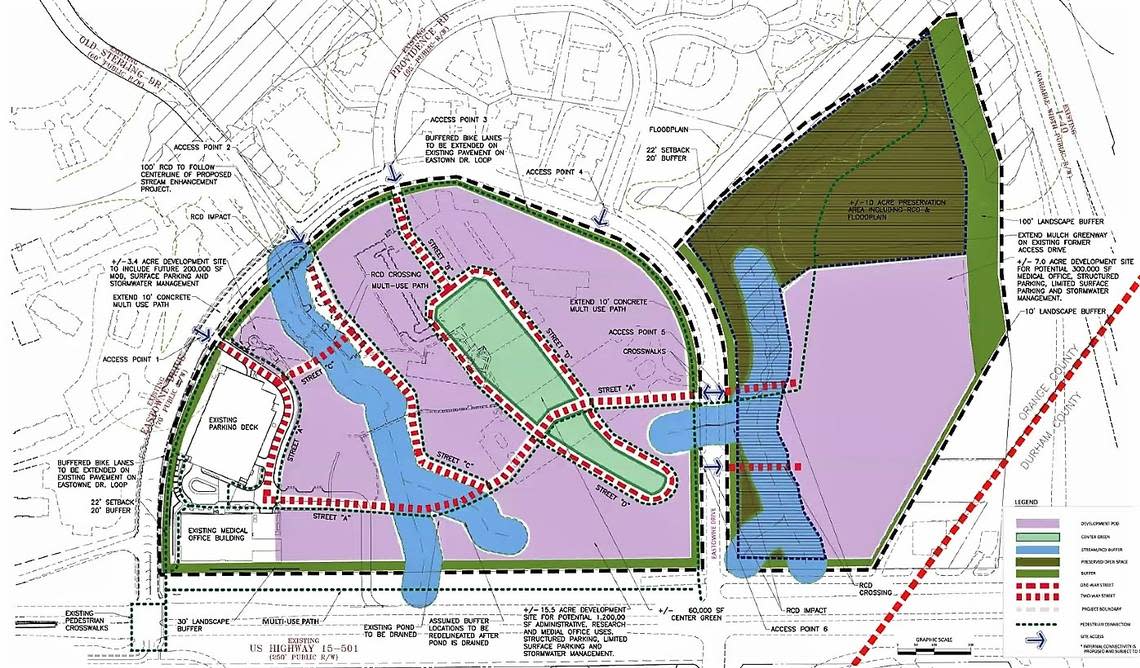UNC Health needs hospital space. Here’s where clinics, outpatient services could go.
UNC Health will return to the Chapel Hill Town Council in January to talk about its Eastowne campus expansion plans and the shape of buildings there for the next 25-plus years.
The 50-acre campus includes about 30 acres in the “horseshoe” formed by Eastowne Drive and U.S. 15-501, and another 20 acres between Eastowne Drive and Interstate 40. It is surrounded by apartments, medical clinics and offices.
A non-binding concept plan submitted recently would add 1.6 million to 1.8 million square feet to the campus, or roughly eight to 10 buildings, plus parking decks, System Director Cameron Ebron said. That’s roughly one new building every three to five years, she said.
New driveways could align with existing streets off the Eastowne Drive loop.
In addition to health-related activities, the campus will have retail space serving visitors, employees and surrounding residents, Ebron said. The goal is a walkable, compact campus for outpatient and clinic services, leaving more space on the Manning Drive main campus for inpatient beds.

UNC Health finished the first phase of redevelopment last year: a new medical building and parking deck. The project team is applying now for a permit to drain a farm pond on the site, said Bill Derks, development engineer with McAdams Co.
The land will lie fallow for about a year to let the stream feeding the pond resume its normal course, revealing the natural buffers.
The council is scheduled to review the concept plan Jan. 11 and provide feedback. The council does not vote on concept plans.
An official conditional zoning application for the campus master plan is expected by spring, town staff said. Approval would allow UNC to submit specific building plans in the future for town staff and potentially Community Design Commission approval.
Environment, traffic, housing concerns
UNC Health has been actively planning the expansion since 2017, but talks with the town were put on hold in early 2020, said Simon George, vice president for UNC Health Care System real estate development.
The system would like to see its whole expansion plan approved next year, he said, but the push, if talks again hit a snag, will be getting the second building approved. That building could open today and still not meet UNC Health’s space needs, George said.
Early council feedback, following a November presentation concerned whether UNC could add workforce housing, meet transportation challenges and preserve the natural environment.
A 2019 environmental report noted the 20-acre tract — one of Orange County’s natural heritage sites — is “worthy of protection in its natural condition,” due in part to its rich soils, mature hardwoods and location along the Dry Creek floodplain.
According to the report, it’s also one of the last remaining links in a wildlife corridor between Duke Forest and Jordan Lake, and has wetlands and streams that feed New Hope Creek.
The preservation of key natural areas, which are rare in that part of Chapel Hill, is important, Council member Amy Ryan said. That includes the steep slopes, as well as the swampy areas and lowlands, Council member Adam Searing added. He suggested building more densely inside the Eastowne Drive loop and preserving more land in the natural heritage area.

Others, including Council member Paris Miller-Foushee, said housing for health care workers who can’t afford to live in Chapel Hill now “should be central to the expansion plan.” Miller-Foushee said she also could support some commercial space in the plan.
Council member Tai Huynh backed her call for housing, or support for local housing efforts, such as a low- or no-interest loan fund that could build and preserve affordable housing. Other members suggested UNC consider investing in the town’s 2200 Homestead Road housing project, which needs money.
Traffic — and pedestrian and bike access — will be another challenge. Town staff is coordinating with the council and with developers and owners of several large parcels south of U.S. 15-501 to plan for a regional network of streets and greenways.
In December, Community Design Commission members agreed with the council’s environmental concerns but wanted more details about the buildings and landscaping to offer feedback.
Commissioner Ted Hoskins asked project officials to make sure “critically important” wayfinding signs are posted to avoid confusing visitors to the campus. He and others also sought more details about green space, especially about how employees could enjoy it.
“I’m very much looking forward to seeing this again as you develop some more design detail,” Hoskins said.
Commissioner Scott Levitan said he appreciates the campus-wide approach to developing a “phenomenal land asset,” but he would like to learn more about the design of a roughly two-acre central green space inside the loop.
UNC Health has an opportunity at Eastowne “to really be a leader on sustainability,” he said.
“I do encourage the continued thought about making this more of a woodland setting than a green lawn, because I don’t think a green lawn is the most effective, sustainable strategy,” Levitan said. “To that point, I think UNC has the responsibility and also the interest (in its strategic plan) to really overlay an environment sustainability strategy on this campus to guide the development as you go forward.”
The Orange Report
Calling Chapel Hill, Carrboro and Hillsborough readers! Check out The Orange Report, a free weekly digest of some of the top stories for and about Orange County published in The News & Observer and The Herald-Sun. Get your newsletter delivered straight to your inbox every Thursday at 11 a.m. featuring links to stories by our local journalists. Sign up for our newsletter here. For even more Orange-focused news and conversation, join our Facebook group "Chapel Hill Carrboro Chat."
